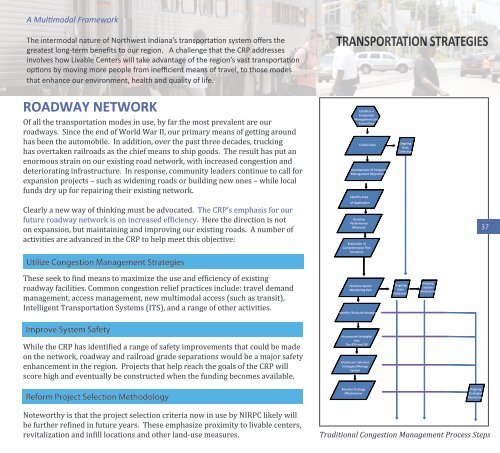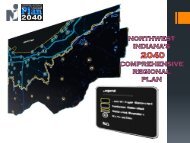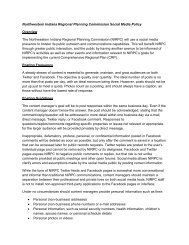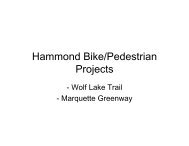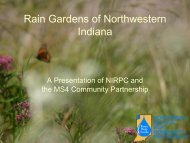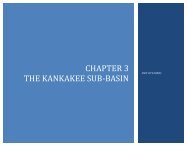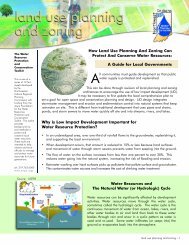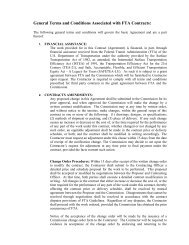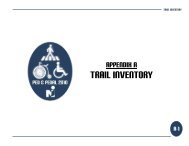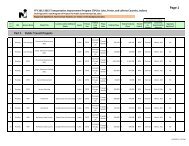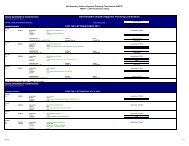Comprehensive Regional Plan - Northwestern Indiana Regional ...
Comprehensive Regional Plan - Northwestern Indiana Regional ...
Comprehensive Regional Plan - Northwestern Indiana Regional ...
You also want an ePaper? Increase the reach of your titles
YUMPU automatically turns print PDFs into web optimized ePapers that Google loves.
A Multimodal Framework<br />
The intermodal nature of Northwest <strong>Indiana</strong>’s transportation system offers the<br />
greatest long-term benefits to our region. A challenge that the CRP addresses<br />
involves how Livable Centers will take advantage of the region’s vast transportation<br />
options by moving more people from inefficient means of travel, to those modes<br />
that enhance our environment, health and quality of life.<br />
TRANSPORTATION STRATEGIES<br />
ROADWAY NETWORK<br />
Of all the transportation modes in use, by far the most prevalent are our<br />
roadways. Since the end of World War II, our primary means of getting around<br />
has been the automobile. In addition, over the past three decades, trucking<br />
has overtaken railroads as the chief means to ship goods. The result has put an<br />
enormous strain on our existing road network, with increased congestion and<br />
deteriorating infrastructure. In response, community leaders continue to call for<br />
expansion projects – such as widening roads or building new ones – while local<br />
funds dry up for repairing their existing network.<br />
Establish a<br />
Congestion<br />
Management Sub<br />
Committee<br />
Collect Data<br />
Process followed<br />
Development of Congestion<br />
Management Objectives<br />
Identify Area<br />
of Application<br />
Ongoing<br />
Data<br />
Collection<br />
Clearly a new way of thinking must be advocated. The CRP’s emphasis for our<br />
future roadway network is on increased efficiency. Here the direction is not<br />
on expansion, but maintaining and improving our existing roads. A number of<br />
activities are advanced in the CRP to help meet this objective:<br />
Develop<br />
Performance<br />
Measures<br />
Evaluation of<br />
<strong>Comprehensive</strong> <strong>Plan</strong><br />
Scenarios<br />
37<br />
Utilize Congestion Management Strategies<br />
These seek to find means to maximize the use and efficiency of existing<br />
roadway facilities. Common congestion relief practices include: travel demand<br />
management, access management, new multimodal access (such as transit),<br />
Intelligent Transportation Systems (ITS), and a range of other activities.<br />
Institute System<br />
Monitoring <strong>Plan</strong><br />
Identify /Evaluate Strategies<br />
Ongoing<br />
Data<br />
Collection<br />
Ongoing<br />
System<br />
Monitoring<br />
IImprove System Safety<br />
While the CRP has identified a range of safety improvements that could be made<br />
on the network, roadway and railroad grade separations would be a major safety<br />
enhancement in the region. Projects that help reach the goals of the CRP will<br />
score high and eventually be constructed when the funding becomes available.<br />
Incorporate Strategies<br />
into<br />
The RTP and TIP<br />
Implement Selected<br />
Strategies/Manage<br />
System<br />
Reform Project Selection Methodology<br />
Monitor Strategy<br />
Effectiveness<br />
Ongoing<br />
Strategies<br />
Monitoring<br />
Noteworthy is that the project selection criteria now in use by NIRPC likely will<br />
be further refined in future years. These emphasize proximity to livable centers,<br />
revitalization and infill locations and other land-use measures.<br />
Traditional Congestion Management Process Steps


